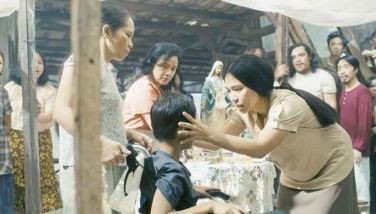Let us now praise the Grateful Dead

August 10, 2003 | 12:00am
 Perhaps one of the most famous Grateful Dead songs is Friend of the Devil, two of which versions appear in the late 1990s compilation albums, The Bridge School Concerts masterminded by Neil Young, and Live on Letterman, music from The Late Show.
Perhaps one of the most famous Grateful Dead songs is Friend of the Devil, two of which versions appear in the late 1990s compilation albums, The Bridge School Concerts masterminded by Neil Young, and Live on Letterman, music from The Late Show.
It is on the Letterman anthology where Garcia does a patently acoustic rendition of the old Dead chestnut, in what could have been among the last live performances of the late guitarist with a couple of missing or is it broken fingers.
Music critics would say that this deficiency had in fact contributed to his trademark round ringing tone when he plucked out the notes on his guitar, evoking images of old frontier America and the bygone days of hippiedom.
Garcia, in his duet with David Grisman on the Letterman album, shows he has more than enough sympathy for the Svengalis of the time. His voice too may be on the side of lilting, almost a la Pete Townshend, but the guitar is unmistakably Garcia.
In the Bridge Concert album, guys from Ministry seem to have lost their industrial strength metal way to do a laidback change of pace in Friend of the Devil, complete with banjos and some other country instruments. If you want country, then this is as rustic as it can get and from a source that you least expect.
In our own wayward youth without benefit of acid- or similarly induced flashbacks, there was but one Dead album we purchased in the ancient Rustan’s Cubao. It was called Blues for Allah, and a cut there might be apt for coup-riddled days: "Help is on the way," or something like that.
There was also a rather longish song on side 2, which occupied a good part of that side of the vinyl, as was the wont in the freeform improvisational spirit of the age, though to our inexperienced ears sounded quite boring.
Trying as best we can to recall details of that extended opus, one might say that the exercise in musical catatonia really tested the patience of the devoted Dead listener.
But who knows if such a song, which should be listened to in the context of the entire Blues for Allah, would not strike us differently today, years after we first heard it?
Sometimes we literally have to grow into the music, and in the case of the Dead’s songs, this may take decades.
Spotted on relative bargain sale (P300 lang!) at the MusicOne SM Megamall was the album Dylan and the Dead, a rarity to be sure, because it brought together two legends of the American counter-culture that could easily stand the recent grim-and-determined US mindset on its weary head.
We thought twice, thrice before parting with our hard-earned money, and resolved to come back for it next time. The sad fact was that there was no next time, because on our subsequent trip to the store Dylan and the Dead was no longer there, bought on the wise and wooly run by either a Dylan fan or a certified Deadhead, or both.
A good song for the two would be Knocking on Heaven’s Door, but that was not likely to be on the album, even if it captures well the backwater ambience and western desperado ambit of both artists.
Jerry Garcia also appears in bassist Rob Wasserman’s album Trios which CD showcases Wasserman’s bass guitar with a rotating pair of musicians. In the album, vocalist Edie Brickell completes the trio with Wasserman and Garcia. The songs American Popsicle and Zillionaire are random memory tunes with open-ended possibilities, and Garcia’s always-tasteful exploration of scales up and down the fretboard counterpoints healthily with Brickell’s almost jazz-like phrasing and Wasserman’s own well-anchored bass.
Anyone who has a dog without a name could do worse than name it Zillionaire, which in the song the trio does.
Our never-ending forays into the bargain bins also had us pick up a book called Skeleton Key, subtitled a dictionary for Deadheads, as well a volume of poetry by the Dead’s lyricist Robert Hunter in a New Directions paperback.
Again we promised to get back to it the next time when we had more money and not just for browsing, yet who knows if the books will still be there or if a fellow Deadhead hid them for future purchase.
The devotion of the band’s fans can easily be explained by that characteristically fleshed out tone of Garcia’s guitar, the recognition of which bonds listeners to a common past. Like we did one night in Sanctum whose bartender is also a Deadhead and friend of whatever devil, with the notes floating inside the walled city like a spark.
BrandSpace Articles
<
>
- Latest
- Trending
Trending
Latest
Trending
Latest
Recommended

































